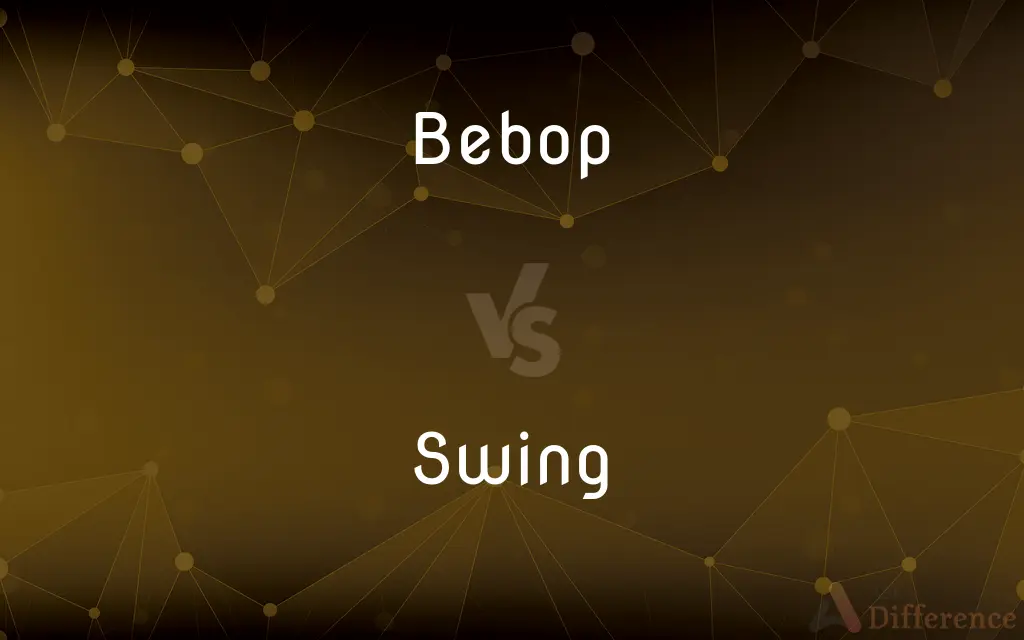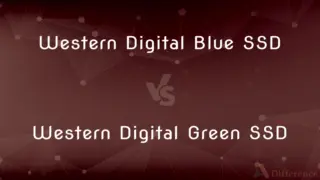Bebop vs. Swing — What's the Difference?
By Tayyaba Rehman — Published on January 29, 2024
Bebop is a complex, fast-paced style of jazz emphasizing improvisation and technical skill, while Swing is a rhythmically fluid, danceable jazz genre popular in the 1930s-1940s.

Difference Between Bebop and Swing
Table of Contents
ADVERTISEMENT
Key Differences
Bebop emerged in the 1940s as a reaction to the Swing era, characterized by its complex harmonies and fast tempos. It focuses on small-group improvisation and is known for its technical difficulty. Swing, on the other hand, was the dominant form of jazz in the 1930s and 1940s, marked by its smooth, flowing rhythm and orchestral arrangements. It was designed to be dance-friendly and accessible to a wide audience.
The rhythm in Bebop is syncopated and unpredictable, often featuring irregular phrasing and a focus on individual musicians' solos. This style challenges both the musicians and listeners with its intricate melodies and harmonies. In contrast, Swing emphasizes a steady, swinging rhythm that's consistent and easy to follow, making it ideal for dancing. The rhythm section in Swing lays down a solid, grooving foundation that drives the dance beat.
Bebop typically uses small ensembles, like quartets or quintets, allowing for greater freedom and interaction among musicians. Its compositions are often complex, with an emphasis on showcasing the virtuosity of the players. Swing, however, is often played by big bands, featuring brass sections, woodwinds, and rhythm sections, creating a fuller, richer sound that's more structured compared to the fluidity of Bebop.
In terms of melody, Bebop is known for its intricate and often dissonant melodies, which require a high level of skill to perform. It's more experimental and less formulaic than Swing. Swing melodies, however, are usually more straightforward, melodic, and repetitive, making them easily recognizable and memorable for listeners.
Bebop's audience is generally more focused on listening and appreciating the musicianship and complexity of the music. It's considered more of an "art" form of jazz. Swing, however, was widely popular with mainstream audiences, with its performances often being large-scale events and dance halls filled with energetic dancers.
ADVERTISEMENT
Comparison Chart
Era and Origin
1940s, as a reaction to Swing
1930s-1940s, peak of jazz popularity
Rhythm and Tempo
Fast, complex, syncopated
Smooth, steady, danceable
Typical Ensemble
Small groups (quartet, quintet)
Large bands (brass, woodwinds)
Melody and Harmony
Intricate, dissonant
Straightforward, melodic
Audience and Purpose
Focused on musicianship, less mainstream
Dance-oriented, widely popular
Compare with Definitions
Bebop
Bebop often features irregular phrasing and rhythms.
The Bebop tune's irregular rhythm challenged even the most skilled dancers.
Swing
Swing is a rhythmically fluid genre of jazz that's conducive to dancing.
The Swing band's performance had everyone on the dance floor.
Bebop
Bebop is a jazz style known for fast tempos and complex improvisation.
Charlie Parker's performances epitomized the energetic nature of Bebop.
Swing
(Music) To play (music) with a subtle, intuitively felt sense of rhythm.
Bebop
Bebop is characterized by small ensembles and interactive playing.
In a typical Bebop band, each musician gets a chance to solo and showcase their talent.
Swing
(Music) Relating to or performing swing
A swing band.
Bebop
It emphasizes technical skill and intricate melodies.
The Bebop session highlighted the musicians' exceptional improvisational abilities.
Swing
It was popular in the 1930s and 1940s and often played by big bands.
The Swing era was defined by the sounds of big bands like Glenn Miller Orchestra.
Bebop
It developed as a more serious, artful form of jazz.
Bebop was a departure from the dance-oriented Swing era, focusing more on artistic expression.
Swing
Swing music is known for its smooth, steady, and swinging rhythm.
The steady beat of the Swing tune made it a favorite among dancers.
Bebop
Bop.
Swing
It features more structured and repetitive melodies.
Swing music's catchy melodies made it widely popular with mainstream audiences.
Bebop
(music genre) An early form of modern jazz played by small groups and featuring driving rhythms and complex, often dissonant harmonies.
Swing
Swing was a dominant form of jazz in its peak era.
During its heyday, Swing music was synonymous with jazz.
Bebop
(intransitive) To participate in bebop jazz, such as by dancing in a way associated with the genre.
Bebop
To walk in an easygoing, carefree manner.
Bebop
An early form of modern jazz (originating around 1940)
Bebop
Dance the bebop
Common Curiosities
What is Bebop in jazz?
Bebop is a style of jazz characterized by fast tempos, complex improvisation, and intricate melodies.
When did Bebop emerge?
Bebop emerged in the 1940s as a reaction to the Swing era.
Is Bebop considered more challenging to play than Swing?
Yes, Bebop is generally considered more technically challenging due to its complex rhythms and melodies.
What kind of audience does Bebop attract?
Bebop usually attracts an audience focused on serious listening and appreciation of musicianship.
What kind of bands typically played Swing music?
Swing music was often played by large bands or orchestras with brass and woodwind sections.
Was Swing music popular with mainstream audiences?
Yes, Swing music was very popular and widely accessible, especially for dancing.
How is Swing music different from Bebop?
Swing music has a smoother, more steady rhythm and is more dance-oriented compared to the complex and fast-paced Bebop.
Were there famous musicians associated with Bebop?
Yes, musicians like Charlie Parker and Dizzy Gillespie were famous for their Bebop style.
How did Bebop influence jazz music?
Bebop influenced jazz by introducing more complex harmonies and a focus on improvisational skill.
Can Bebop be used for dancing?
While it's possible, Bebop's irregular rhythms and fast pace make it less suitable for traditional dancing compared to Swing.
Were Swing bands larger than Bebop ensembles?
Typically, yes. Swing bands were larger compared to the smaller groups commonly used in Bebop.
What is a defining feature of Swing rhythm?
Swing rhythm is defined by its smooth, flowing, and steady beat.
Is improvisation a key element in Bebop?
Yes, improvisation is a central element in Bebop, showcasing individual musicians' skills.
Did Swing music influence other genres?
Yes, Swing influenced various other genres and was a significant part of jazz's evolution.
Did Bebop and Swing coexist at any point in time?
Yes, there was a period during the 1940s when both styles coexisted, although Bebop was seen as a reaction against Swing.
Share Your Discovery

Previous Comparison
AK47 vs. AK74
Next Comparison
Western Digital Blue SSD vs. Western Digital Green SSDAuthor Spotlight
Written by
Tayyaba RehmanTayyaba Rehman is a distinguished writer, currently serving as a primary contributor to askdifference.com. As a researcher in semantics and etymology, Tayyaba's passion for the complexity of languages and their distinctions has found a perfect home on the platform. Tayyaba delves into the intricacies of language, distinguishing between commonly confused words and phrases, thereby providing clarity for readers worldwide.
















































